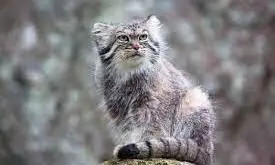
Rarest wildcat discovered on Mount Everest in a first
text_fieldsKathmandu: Researchers have spotted the planet's rarest wild cat, Pallas's cat, on Mount Everest for the first time. They were seen in the Sagarmatha National Park in Nepal.
The discovery was made by the 2019 National Geographic and Rolex Perpetual Planet Everest Expedition and a paper was published about it in Cat News. Dr. Tracie Seimon of the Wildlife Conservation Society's Zoological Health Program, who co-led the expedition said that it is phenomenal to discover proof of this rare and remarkable species at the top of the world.
The Pallas's cat is small compared to other cats. Its head-and-body length ranges from 46-65 cm with a 21-31 cm long bushy tail. It is characterised by dense light grey fur and rounded ears set low on the sides of the head. Its pupils are rounded, a unique feature.
From April 7 to May 2, 2019, the expedition team of scientists in the biology field collected environmental samples from two locations 6 km (3.7 miles) apart at 5,110 and 5,190 m (16,765 and 17,027 ft) elevation above sea level along Sagarmatha National Park on Mount Everest's Southern Flank.
According to the report, this wild cat looks larger than it is with short legs, a stocky, compact build, and long fur. "The hair on its underparts is nearly twice as long as on the top and sides, an adaptation that keeps Pallas's cat warm in the extreme cold winter conditions that are typical of its habitat. The coat colour of Pallas's cat varies from grey in the north of its range to tawny or fox-red in some parts of the south of its range."
They need a large area to survive and their habitat specialisation makes them vulnerable to habitat fragmentation and degradation. Overgrazing livestock and conversion to arable land are the major threats to the species. Increased disturbances by humans including mining, infrastructure developments, and livestock husbandry are harming them. Prey depletion and poaching are also reasons for their decline.























